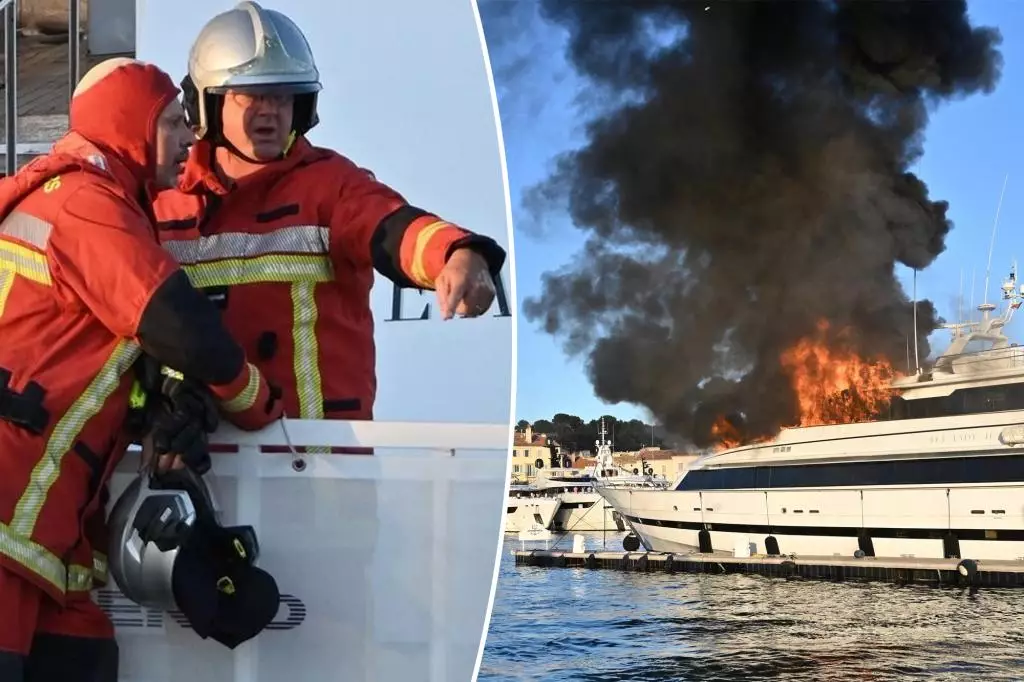In the world of opulence and extravagance, few symbols embody wealth more vividly than a superyacht. These majestic vessels serve as floating palaces, epitomizing the pinnacle of luxury, exclusivity, and technological marvel. Yet, behind the shimmering glass and polished decks lies a fragile reality—one that can be dramatically upended by the unpredictable nature of fire and disaster. The recent burning of the Sea Lady II in St. Tropez is a stark reminder that even the most lavish symbols of wealth are susceptible to mishaps, exposing the vulnerabilities concealed beneath their glossy exteriors.
This incident underscores how the perception of invincibility surrounding luxury yachts is often superficial. For the onlookers lining the piers and cafes of St. Tropez, the sight of a blazing superyacht appeared as a spectacular spectacle—an event that added drama to a scene otherwise defined by finesse and glamour. However, beyond the spectacle, there exists a sobering truth: the safety and preservation of these floating treasures are precarious, dependent on technology, skilled crew, and a bit of luck.
The Risks Hidden Beneath the Elegance
The circumstances that led to the Sea Lady II’s fire are still under investigation, but this tragedy raises questions about the safety protocols and maintenance standards of high-end vessels. Fires aboard yachts are not new—they have a notorious history of destruction, often originating from engine malfunctions, electrical faults, or fuel leaks. Despite advances in safety technology, the risks remain.
What makes these events even more alarming is the community’s attitude toward risk. In the rarefied environment of St. Tropez’s luxury scene, a blaze like this does little to disturb the social order. Partygoers, celebrities, and jet-setters continue to indulge and dance as if nothing has occurred, highlighting how disaster is often normalized in the world of excess. This detachment—where spectacle overshadows concern—can sometimes hinder prompt safety responses and long-term preventative measures.
Furthermore, the incident reveals the vulnerability of surrounding vessels. With anti-pollution barriers and quick evacuations, emergency responders demonstrated responsiveness, yet the difficulty in boarding the yacht during the fire hints at systemic safety gaps. As the yachts—boasting everything from jet skis to high-end fishing gear—are often operated by a small crew, the burden to manage emergencies is immense. A fire does not only threaten property but also human life, and a tragic loss of life could be imminent should safety protocols fail or be inadequately implemented.
The Cultural Dichotomy of Wealth and Risk
The spectacle of wealth—epitomized by the posh superyachts, celebrity sightings, and luxury villas—often masks the inherent risks and the fleeting nature of such riches. In the case of the Sea Lady II, the vessel’s owner remains anonymous, an emblem of privacy that wealth affords but does not guarantee safety. Rentals for the yacht reach staggering weekly rates, yet this investment offers no immunity from disaster.
This paradoxical relationship between wealth and vulnerability is vividly illustrated by the scene in St. Tropez. Amid a season bustling with high-profile personalities like Kylie Jenner and Timothée Chalamet, the incident seemed almost an afterthought—a fleeting moment in a town where luxury consumption is the currency of the day. The onlookers’ reactions, masks on faces and tears in their eyes, highlight an acceptance of risk—a belief that such things happen to others, not to the privileged.
The recurrence of yacht fires in the French Riviera region also hints at a deeper issue: the reckless underestimation of risk in environments built on opulence and excess. When safety becomes less of a priority than appearances, the likelihood of tragedy increases. It begs the question—are the measures in place sufficient for the safety of the wealthy elite and their floating palaces? Or do these incidents expose cracks in the veneer of perfection, reminding us that no amount of wealth can fully insulate us from the destructive power of fire?
The Unforgiving Nature of the Lifestyle
Ultimately, the fire aboard the Sea Lady II exemplifies the perilous edge of the yacht-owning lifestyle—an existence characterized by material splendor, yet shadowed by unpredictable hazards. While the incident was contained without casualties and surrounding yachts were preserved, the event serves as a stark reminder to the affluent: the more ostentatious the display of wealth, the more exposed one’s vulnerabilities become.
It also raises uncomfortable realities about the environmental implications of yacht fires. The deployment of anti-pollution barriers indicates an awareness of ecological risk, yet each incident releases pollutants and possibly toxic chemicals into the pristine waters of the Riviera. In a region beset by environmental scrutiny and climate challenges, this fire adds another layer of concern about the sustainability of the superyacht culture.
As the world increasingly scrutinizes the excesses of the ultra-wealthy, events like the Sea Lady II fire force a reconsideration of priorities. Do the dazzling displays of wealth justify the risks and environmental costs? Or are they merely fleeting illusions that can be shattered by the simplest of accidents? In this delicate balance, the true lesson lies not in the spectacle itself but in understanding the fragile veneer of luxury that, while mesmerizing, is ultimately vulnerable to the capriciousness of nature and human error.

